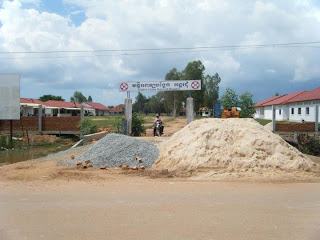 |
There often appears to me to be an absence of common sense or perhaps better put an absence of any good sense. After trying to explain to my VA & R that when the staff on medical population ward record every patient's vital signs as the same, they are not even using their 'common sense' (as well as lying & being lazy) because not every one can possibly have exactly the same observations all the time. R & my VA looked blankly at me at the use of the phrase 'common sense', so I showed them the translation from my iPhone khmer dictionary App, they both responded with "We don't use that word in Khmer!'
And I wonder why.....?
Below are a few examples from my experience & also those of fellow NGO workers in health;
Whilst reviewing & editing the nursing protocols J read this extract out to me "Thermometer could stimulate the vagus nerve in the rectum & cause cardiac arrhythmia". There we were thinking the vagus nerve is a cranial nerve. The same set of nursing protocols also instructs that a 3 ml syringe measuring 6 cm in length needs to be inserted 12.5 cm into the rectum. Leading J & I to wonder if this was a veterinary nursing protocol we were reading. Although, the endemic lack of common sense is accommodated for in the previous paragraph of the same rectal medication protocol with this instruction "remove needle from syringe before inserting in anus."
After introducing a sepsis protocol to a group of surgeons, which clearly stated the normal parameters of temperature, pulse, blood pressure & respiratory rate, the deviation from which with infection indicates sepsis, a doctor then asked me this question "How do you know that a patient is getting better & has recovered?" My VA chose not to translate this for me at the time but handled the question herself. She is a 21 year english literature student, with a more than average quota of good sense.
L has a lot of examples of common sense failure in her work place - most of the photos below are hers. She was delivering CPR training in a health centre & asked the staff how long they would feel for a pulse in a collapsed patient. The directors response "5 minutes" - any hope that this was a confusion was down to translation error was destroyed when a nurse then asked, "When we get a return of circulation, can we send them home?"
Another time, L's ER was transferring a patient from her hospital to the provincial hospital, before the ambulance left she noticed that the oxygen cylinder gauge was on red (nearly empty), she pointed this out to the ambulance driver & staff going on the transfer, who told her that there was still oxygen in the cylinder & refused to change it. They ran out of oxygen on route & the patient died. Actually this story may be less about common sense & more about straight forward negligence.
 |
| Where the builders at L's hospital thought it would be the best place to put a pile of bricks - the entrance to the emergency room |
 |
| So then L goes out to discover the sand & gravel for the building work has been put in an even better place - obstructing the entrance to the entire hospital. |
 |
| Also at my L's hospital - the material thought best to use for privacy & dignity of all patients |



No comments:
Post a Comment